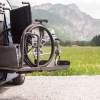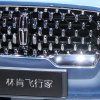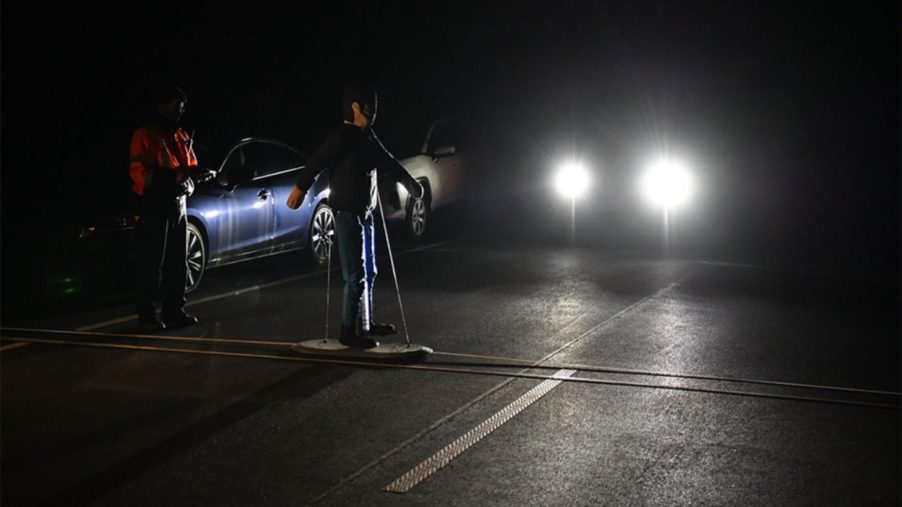
Study Finds Pedestrian Detection Systems Ineffective at Night
IIHS pedestrian detection and automatic emergency braking study article highlights:
- Analyzing roughly 1500 real-world crashes, the IIHS found that automatic emergency braking and pedestrian detection can reduce crash and injury rates
- However, these ADAS features fail to make a significant difference at 50-mph-plus speeds, in poorly-lit areas, and at night
- The IIHS is working on a dedicated nighttime testing regimen for pedestrian detection and automatic emergency braking, and some cars are already scoring well
As an organization dedicated to improving car safety, it’s the IIHS’s job to stay on top of the latest safety tech developments. And that tech has long since evolved past just airbags and crumple zones. With advanced driver-assistance system (ADAS) features like automatic emergency braking becoming increasingly common, the IIHS isn’t just making their presence required for Top Safety Pick. It’s also ramping up the ways it evaluates these safety features. And its latest test results suggest that pedestrian detection has an eyesight problem once the sun sets.
A new IIHS study shows that automatic emergency braking and pedestrian detection work
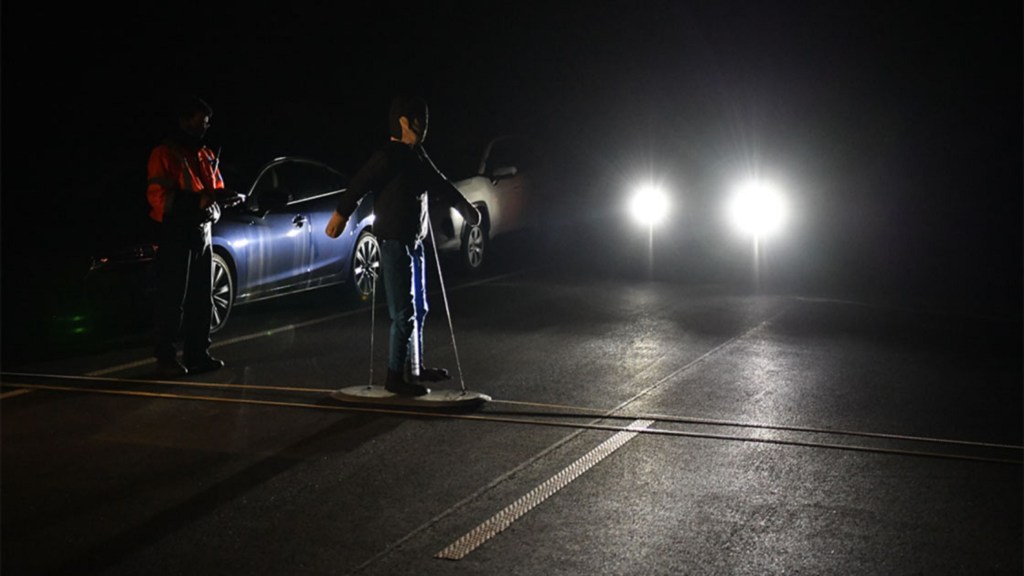
The IIHS’s most recent study involved analyzing roughly 1500 police-reported crashes involving an assortment of 2017-2020 vehicles. In addition to factoring in the age, gender, and other demographic factors of the drivers, the IIHS compared the crash rates for vehicles with and without automatic emergency braking (AEB) equipped with pedestrian detection. The organization then determined what effect ‘pedestrian AEB’ had based on the ambient light, speed limit, crash severity, and if the car was turning or not.
First, the good news is that automatic emergency braking with pedestrian detection is a safety feature that genuinely works. Based on the IIHS’s findings, pedestrian AEB lowered pedestrian crash rates by 27% overall. Furthermore, it reduced overall injury rates by 30%.
Considering fatal car crash rates rose recently—up 51% since 2009 according to the US Department of Transportation—this is heartening to hear. But it’s not just good news for distracted drivers who panic-stop before crosswalks, but also the pedestrians, distracted or otherwise, in those crosswalks. And most of us, myself included, have been at least one of those people at some point.
However, while the overall pedestrian detection news is rosy, the IIHS study also revealed some troubling details. Namely, that pedestrian detection doesn’t seem to, well, detect in the dark or at high speeds.
But pedestrian detection and AEB have a problem: they’re blinded by speed and the night
On the plus side, the ADAS technology reduced pedestrian crash rates by 32% on roads with 25-mph-or-lower speed limits and by 34% on roads with 30-35 mph speed limits. But on roads with speed limits 50 mph and higher, pedestrian AEB had no impact. Neither did it help when the equipped car was turning.
Even more worrying, however, is what happened when the lighting changed. The IIHS study found that pedestrian AEB lowered crash rates by 32% in daylight and 33% in artificial lighting, such as streetlights. Yet in unlit or poorly-lit areas, pedestrian detection made no difference.
The worrying part isn’t just that this fancy (and sometimes pricey to repair) technology seemingly doesn’t work at night, though. According to the US DOT, 73% of pedestrian crashes happen between 6 pm and 6 am, Consumer Reports notes. So, while pedestrian AEB can help, it seemingly doesn’t make a difference during the most crucial part of the day.
Fortunately, this might not be the case for much longer.
The IIHS is working on a nighttime pedestrian detection and AEB test—and some automakers are already scoring well
After analyzing all these crash reports, the IIHS realized that it needed to develop a nighttime testing regimen for pedestrian detection and automatic emergency braking. Basically, an extension of its current crash and safety testing. And that meant dimming the lights for real.
For its initial data gathering, the IIHS tried testing as many pedestrian detection technology varieties as possible. Specifically, by bringing along multiple vehicles to its test facility and running them along a track during the day, at night, and in full darkness. Each model was tested twice: once with high beams on, and once with low beams. And the test involved the following vehicles:
- 2019 model year:
- Subaru Forester (camera only)
- Volvo XC40 (camera and radar)
- 2020 model year:
- Honda CR-V (camera and radar)
- Hyundai Venue (camera and radar)
- 2021 model year:
- Chevrolet Trailblazer (camera only)
- Ford Bronco Sport (camera and radar)
- Toyota C-HR (camera and radar)
- 2022 model year:
- Volkswagen Taos (radar only)
Admittedly, this was only an initial test. But even so, while it confirmed some things, it also delivered some unexpected results.
Firstly, because its pedestrian AEB relies solely on radar, which isn’t affected by ambient lighting, the Volkswagen Taos did equally well at nighttime and daytime. However, it also had the worst daytime score. Secondly, headlight ratings don’t correlate with pedestrian AEB performance. The IIHS rated one of the C-HR’s headlight options as ‘poor,’ yet it had one of the best nighttime scores.
And speaking of, the C-HR and Bronco Sport had the two highest nighttime scores thanks to their camera-and-radar systems. That doesn’t mean all such systems are created equal, though. The Forester and Trailblazer performed similarly to the Venue, XC40, and CR-V, despite lacking radar.
What does this mean for car safety?
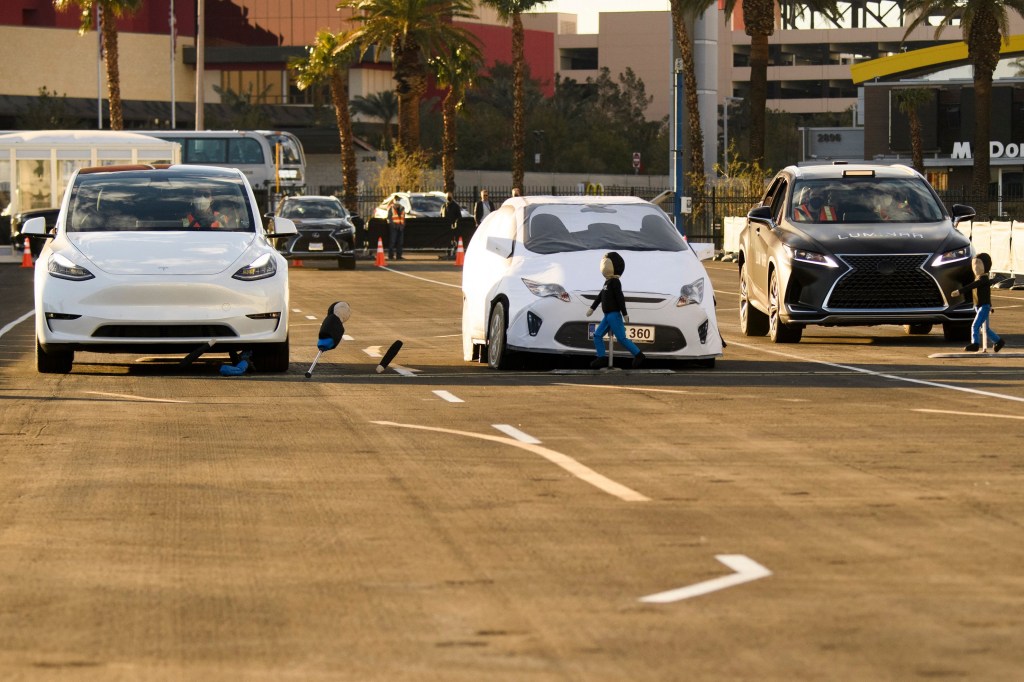
To summarize, pedestrian detection and automatic emergency braking can decrease crash rates. But so far, they don’t work well at high speeds or in poorly-lit areas. And while some pedestrian AEB systems can compensate for poor lighting, not all of them can.
However, after its initial testing, the IIHS noted that some automakers were scoring better than expected. This might be because some of the vehicles tested “[were] too new to be included in our study of real-world crashes,” IIHS safety testing manager David Aylor mused. But it might also show that automakers have already improved their safety tech in the span of a few years. Considering that the Lucid Air just became the first mass-produced car in the US with lidar, it’s likely a mix of both.
So, for now, while somewhat beneficial, pedestrian AEB is still imperfect. Thus, as with any ADAS feature, though it helps the driver, it doesn’t replace adequate training, skill, and attention. And that won’t change even as the technology improves. But through studies like these and rigorous testing, it should work better at night.
It has to—after all, what good’s a safety feature that doesn’t keep people safe?
Follow more updates from MotorBiscuit on our Facebook page.
